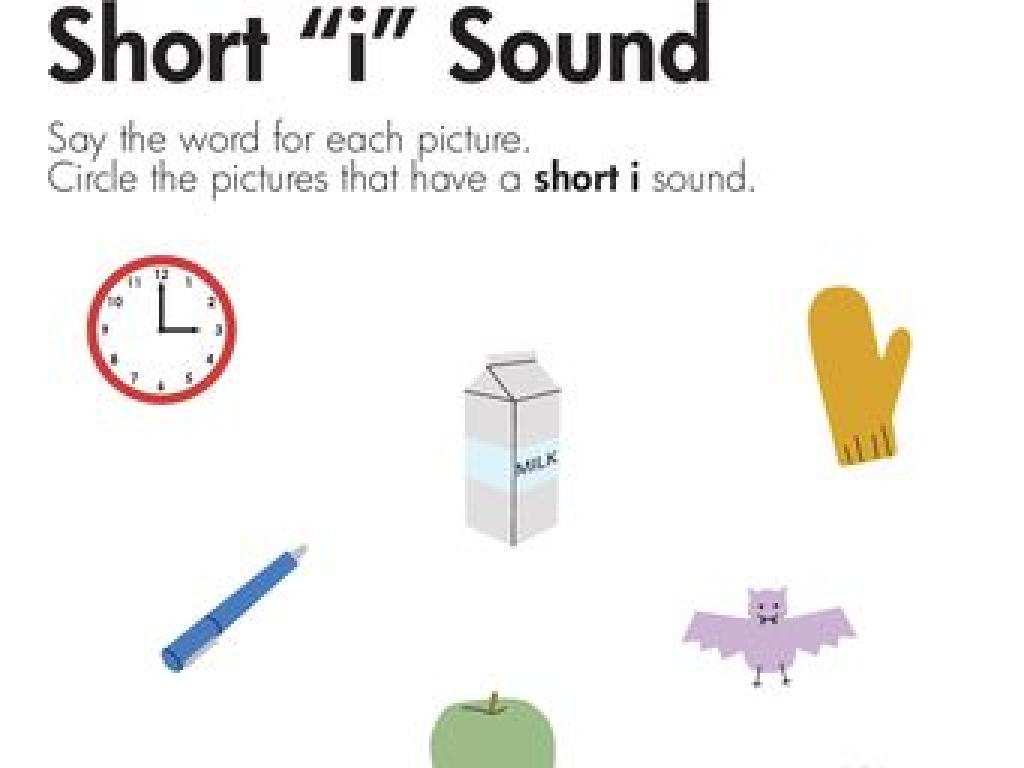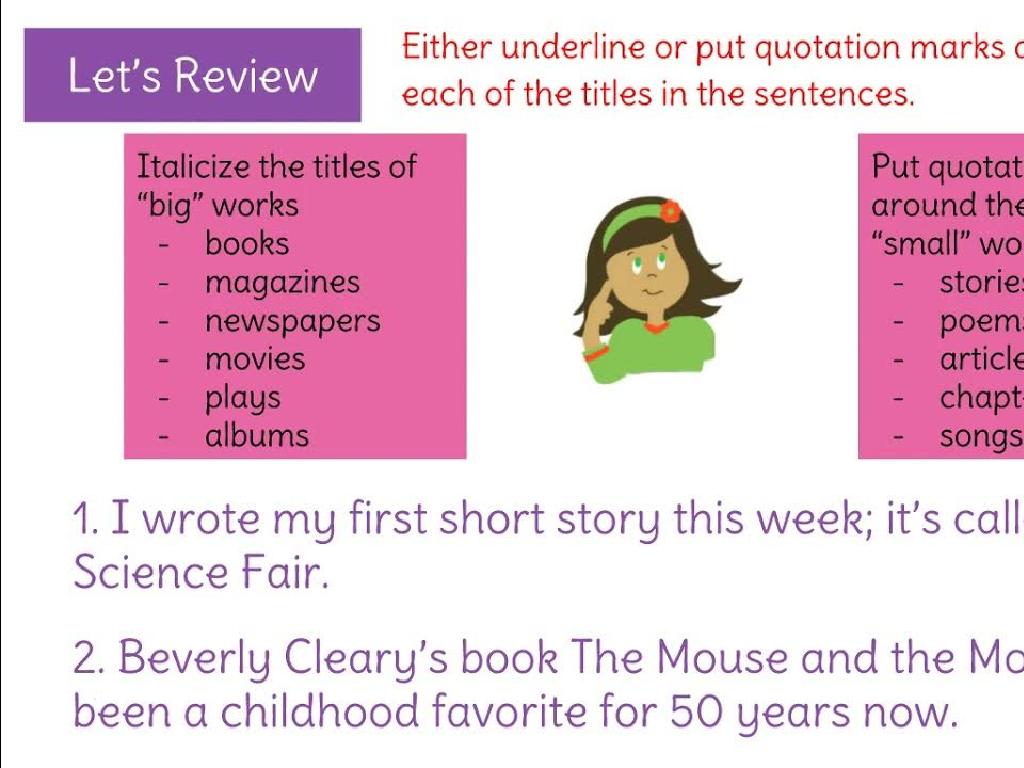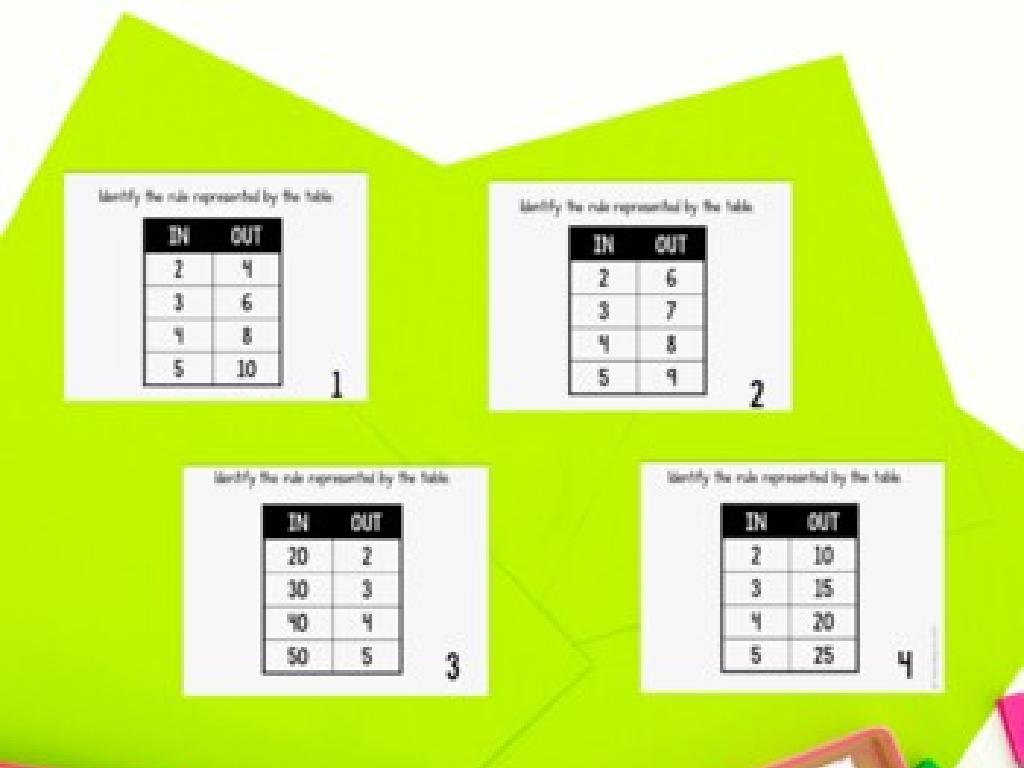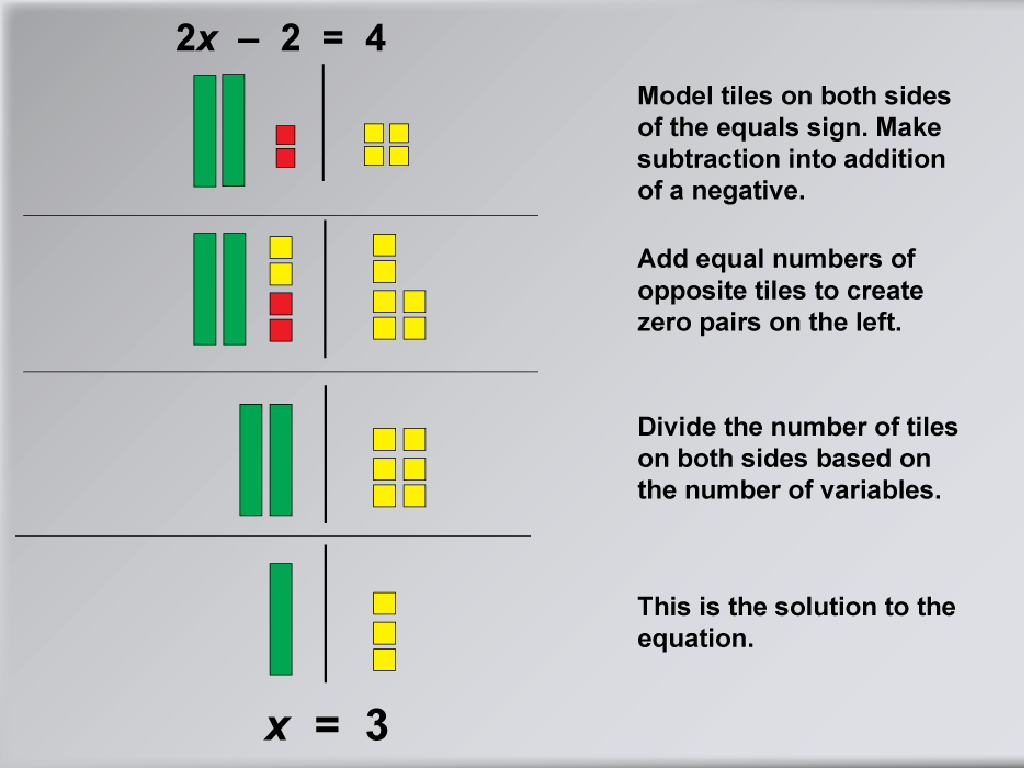Read And Understand Informational Passages
Subject: Language arts
Grade: Eighth grade
Topic: Analyzing Informational Texts
Please LOG IN to download the presentation. Access is available to registered users only.
View More Content
Analyzing Informational Texts
– Purpose of informational texts
– To inform, explain, or educate the reader on a specific topic.
– Distinguish informational vs. other texts
– Informational texts are fact-based, while other writings like fiction tell a story or express opinions.
– Reading comprehension strategies
– Use strategies like summarizing, questioning, and predicting to aid understanding.
– Today’s focus: Understanding passages
|
This slide introduces students to the concept of informational texts and how they differ from other types of writing, such as fiction or opinion pieces. Emphasize that the primary purpose of informational texts is to educate the reader about a particular subject using facts and evidence. Encourage students to think critically about the text’s purpose and to use active reading strategies to improve comprehension. Today’s lesson will focus on applying these strategies to understand informational passages better. Provide examples of informational texts (e.g., articles, manuals, reports) and contrast them with examples of fiction or opinion pieces to highlight the differences.
Exploring Informational Texts
– Define informational text
– Nonfiction text written to share factual information
– Purpose of informational texts
– To educate and inform the reader about a specific topic
– Characteristics of informational texts
– Features like headings, subheadings, and factual details
– Examples in everyday life
– Textbooks, news articles, and instruction manuals
|
This slide introduces the concept of informational texts, which are nonfiction writings aimed at providing facts and knowledge about a particular subject. Emphasize that the main goal of these texts is to educate and inform, not to entertain. Discuss the key characteristics that help identify informational texts, such as the presence of headings and subheadings, structured layout, and the inclusion of factual and statistical information. Provide relatable examples that students encounter in their daily lives, such as textbooks for learning, news articles for staying updated on current events, and instruction manuals for understanding how to operate devices or perform tasks. Encourage students to think of other examples and consider the importance of these texts in their academic and personal lives.
Text Features in Informational Texts
– Explore common text features
– Titles, headings, images, captions, graphs, and more
– Understand features’ roles
– They guide readers and emphasize key points
– Activity: Identify text features
– Examine a passage and note different text features
– Discuss feature findings
|
This slide introduces students to the various text features commonly found in informational texts, such as titles, headings, subheadings, images, captions, graphs, and tables. Emphasize how these features help readers to better understand and navigate the content, highlighting important information and providing visual support for the text. The activity involves students working with a sample passage to identify and note the different text features they find. After the activity, encourage a class discussion where students share their findings and reflect on how each feature contributed to their comprehension of the passage. This will help them to recognize the importance of text features in their own reading and analysis of informational texts.
Understanding Complex Vocabulary
– Deciphering difficult words
– Use roots, prefixes, and suffixes to understand new words.
– Utilizing context clues
– Words are often defined by the sentences around them.
– Practice vocabulary analysis
– Examine how words contribute to the passage’s meaning.
– Strategies for comprehension
|
This slide aims to equip students with strategies to tackle complex vocabulary in informational texts. Emphasize the importance of breaking down words into roots, prefixes, and suffixes to infer meaning. Teach students to use surrounding text – context clues – to define unfamiliar terms. During practice, have students analyze vocabulary within the context of a passage to understand how it contributes to the overall message. Encourage discussion about how word choice affects the tone and clarity of the information presented. Provide examples of complex words and guide students through the process of deciphering them using these strategies.
Main Idea and Supporting Details
– Identifying the main idea
– The main idea is the central point the author wants to convey.
– Locating supporting details
– Look for key sentences or phrases that reinforce the main idea.
– Dissecting a paragraph example
– Analyze a sample paragraph to practice finding the main idea and details.
– Understanding the connection
– Grasp how details bolster the main idea, making it clearer.
|
This slide aims to equip students with the skills to identify the main idea and supporting details in informational texts. Start by explaining that the main idea is the central message or point of a passage, which is usually accompanied by supporting details that reinforce it. Provide strategies for finding evidence within the text, such as looking for repeated ideas or key phrases. Use a specific paragraph as an example to dissect and identify the main idea and supporting details. Discuss how these elements work together to give the reader a full understanding of the author’s message. Encourage students to practice these skills with various texts to improve their analytical reading abilities.
Analyzing the Author’s Purpose
– Understand author’s intent
– Inform, explain, or persuade?
– Is the text providing information, giving an explanation, or trying to convince you?
– Activity: Identify the purpose
– Read passages and determine why the author wrote them
– Discuss findings in groups
– Share and compare interpretations with classmates
|
This slide introduces the concept of understanding an author’s purpose in writing a text, which is a key component of analyzing informational passages. Students should learn to distinguish whether the author’s intent is to inform the reader with facts, explain a concept in detail, or persuade the reader to adopt a certain viewpoint. The class activity involves reading selected passages and determining the author’s purpose for each one. After the individual task, students will form groups to discuss their findings and understand that different readers may perceive the author’s purpose differently. The teacher should facilitate the discussion, ensuring that each student can support their opinion with evidence from the text. Possible activities include analyzing newspaper articles, advertisements, and excerpts from informational books.
Critical Thinking: Evaluating Information
– Assess source credibility
– Is the source trustworthy? Look for author’s credentials, publication date.
– Question the information
– Ask Who? What? When? Where? Why? How? to understand the text better.
– Discuss information validity
– Share thoughts on the text’s accuracy, bias, and usefulness.
– Apply critical analysis
|
This slide aims to teach students the importance of critically evaluating information, especially in the digital age where data is abundant. Start by explaining how to assess the credibility of a source, including checking the author’s qualifications, the recency of the information, and the reputation of the publication. Encourage students to actively question the information presented to them by considering the 5 Ws and H. Facilitate a class discussion where students can evaluate the validity of information from a text, considering aspects like accuracy, bias, and relevance. This will help them apply critical thinking skills to their reading and research. Provide examples of texts for analysis and guide them through the evaluation process.
Group Analysis Activity: Informational Texts
– Break into small groups
– Read the assigned passage
– Analyze text features and vocabulary
– Identify main idea, supporting details, author’s purpose
– Present your findings
– Share your group’s analysis with the class
|
This class activity is designed to foster collaborative learning as students delve into informational texts. By working in small groups, students can engage in discussions that help them understand the structure and content of the passage. The activity requires them to identify key text features such as titles, headings, and images, as well as unfamiliar vocabulary that may need clarification. They should also determine the main idea and supporting details to understand the author’s message and purpose. After the analysis, each group will present their findings, allowing for a comprehensive class discussion and reinforcing the learning objectives. For the teacher: Prepare diverse passages that cover different subjects, ensure each group has a clear copy of their passage, and provide a worksheet to guide their analysis. Possible variations of the activity could include peer review of presentations, a written summary of the group’s findings, or a reflection on the strategies used to understand the text.
Conclusion and Reflection: Informational Texts
– Recap today’s key points
– Reflect on the lesson’s value
– How can these skills help with future reading?
– Homework assignment
– Choose an informational text and write an analysis
– Future application of skills
– Consider how understanding texts benefits academic and real-world scenarios
|
As we conclude today’s lesson, it’s important to revisit the main concepts we’ve covered about reading and understanding informational passages. Encourage students to think about how these skills will aid them not just in their academic pursuits but also in comprehending real-world texts such as news articles, manuals, and reports. For homework, students should find an informational text and prepare a written analysis, focusing on the author’s purpose, main ideas, and supporting details. This exercise will reinforce today’s lesson and provide practice in critical reading and writing. In the next class, we can discuss these analyses to further cement the students’ understanding.






